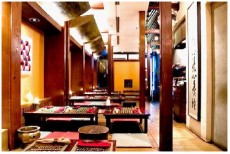There is something to be said for eating exotic meals in their natural settings. That is the reason why every time I go to India, I make a determined effort to eat off the plantain leaf at least once during my trip, or go to an authentic Marathi or Gujarati restaurant in Mumbai serving traditional regional cuisine. But this is not easy now. Everyone is onto the Punjabi menu of Chole and Puri/Bature or the dreaded Biryani (!).
Eating all the dishes of a traditional feast off the plantain leaf with your right hand is a cultural, gastronomic, religious experience all on its own. The fresh odor of the leaf, and the array of dishes and the physicality of eating engage all the senses.
[Incidentally, chicken and mutton biriyani are enormously popular in Tamil Nadu for reasons that I don’t fully understand. Party workers during election season demand that they are given non-vegetarian biriyani, and at least a “quarter,†the quarter being a quarter bottle of whiskey or vodka. Alcoholism is a very big and widespread social problem all across Tamil Nadu today. Increasing number of young adults (both men and women) — some in high schools — are alcoholics This is another topic for another day.]

So, during a recent visit to New York City, on the suggestion of my daughter, I stepped into the Hangawi Vegan Korean restaurant on E 32nd St. After luxuriating in the hallowed rooms of the New York Public Library, we went to the restaurant, a short walk away, in Koreatown. Even as I walked into the Korean spot the atmosphere promised a rare treat for this vegetarian. However, I had to tweak the menu here and there, to make up a decent meal.
As much as the food, it was the ambience of this setting also that blew me away. First, you remove your shoes. The maître d’ ushers you into the eating spot, which is not strictly a traditional table. You are seated at floor level “tables†just 18†tall. For those with unfoldable legs, they have provided a pit just below the table into which you can leave your legs hang, touching the ground.
Kondo-esque simple decorations with Chinese and Korean characters decorate the walls. The atmosphere is one of serenity and peace. In this ambience, you just don’t eat the food. You savor it — its shades of texture, aroma, tastes and flavors. We had Korean fine noodles with kimchi and an assortment of vegetables, vegetable dumplings with rice cakes. The noise and bustle of the street, and also from other guests was muted, and you could experience the satisfying meal with total focus.
On our way out, I recalled another meal I ate years ago at Watan, an Indian restaurant, again in New York City, that attempted this ambience with a Gujarati village as the setting. Seated at round tables under a [fake] banyan tree with its overhanging branches with subdued lighting keeping the outside shut out, you could enjoy the traditional Gujarati fare with all your senses. In typical Indian fashion the food was unlimited and the meal was for a fixed price.
So, restaurants to be successful must pay attention not only to the quality — and quantity — of their fare but also to the ambience. It does not have to be lavish but has to be aesthetically pleasing. ♠
